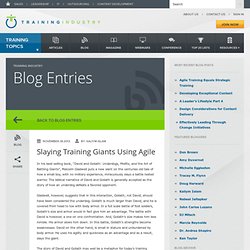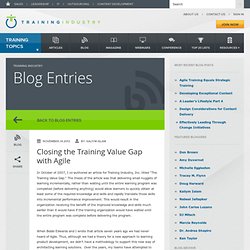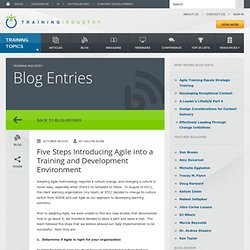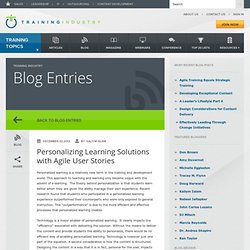

Effective Performance with A.G.I.L.E. Instructional Design by Jennifer Neibert. “Effective evaluation improves the quality of what we do, increases the efficiency in how we do it, determines the degree to which we can consistently achieve what we set out to do, and measures the strategic value of it all.

Performance support plays a vital role in enabling all of this.” If you’ve read the other two articles in this series, then you know Conrad Gottfredson developed the A.G.I.L.E. instructional design methodology to empower learning teams to create and deploy a core learning solution, with a complementary performance support system, more rapidly. You also know the first two steps in the methodology , align and get set, are key to identifying and validating business performance needs and defining requirements for learning and performance interventions. Agile Learning Design. Agile Learning Design refers to any approach to content development that focuses on speed, flexibility and collaboration.

The term evolved from the software development industry, in which electronic content development (e.g., e-learning) has similar characteristics to software development. One of the fastest growing trends in the training field is the increased need by organizations for rapidly developed learning content. In today’s highly competitive global marketplace, concepts such as “time-to-proficiency” have become high priorities for businesses everywhere. Slaying Training Giants Using Agile. November.18.2013 By: Kaliym Islam In his best-selling book, “David and Goliath: Underdogs, Misfits, and the Art of Battling Giants”, Malcolm Gladwell puts a new slant on the centuries old tale of how a small boy, with no military experience, miraculously slays a battle tested warrior.

The biblical narrative of David and Goliath is generally accepted as the story of how an underdog defeats a favored opponent. Gladwell, however, suggests that in this interaction, Goliath, not David, should have been considered the underdog. Goliath is much larger than David, and he is covered from head to toe with body armor. In a full scale battle of foot soldiers, Goliath’s size and armor would in fact give him an advantage. Closing the Training Value Gap with Agile. November.14.2012 By: Kaliym Islam In October of 2007, I co-authored an article for Training Industry, Inc. titled "The Training Value Gap.

" The thesis of the article was that delivering small nuggets of learning incrementally, rather than waiting until the entire learning program was completed (before delivering anything) would allow learners to quickly obtain at least some of the required knowledge and skills and rapidly translate those skills into incremental performance improvement. This would result in the organization receiving the benefit of the improved knowledge and skills much earlier than it would have if the training organization would have waited until the entire program was complete before delivering the program. When Bobbi Edwards and I wrote that article seven years ago we had never heard of Agile.
Thus, although we had a theory for a new approach to learning product development, we didn't have a methodology to support this new way of architecting learning solutions. Five Steps Introducing Agile into a Training and Development Environment. October.08.2013 By: Kaliym Islam Adopting Agile methodology requires a culture change, and changing a culture is never easy; especially when there’s no template to follow.

In August of 2012, the client learning organization (my team) at DTCC decided to change its culture switch from ADDIE and use Agile as our approach to developing learning solutions. Prior to adopting Agile, we were unable to find any case studies that documented how to go about it. Agile Training Equals Strategic Training. September.26.2014 By: Kaliym Islam Strategic training has been defined as one that aligns a company’s objectives with everyday training needs.

It is a comprehensive framework that strikes a balance between the need for training and organizational constraints. Ed Trolley, the co-author of “Running Training Like a Business,” doesn’t use the term strategic training, but his vision of how to run a training organization is inclusive of many of the principles previously described. Personalizing Learning Solutions with Agile User Stories. December.02.2013 By: Kaliym Islam Personalized learning is a relatively new term in the training and development world.

This approach to teaching and learning only became vogue with the advent of e-learning. The theory behind personalization is that students learn better when they are given the ability manage their own experience. Recent research found that students who participated in a personalized learning experience outperformed their counterparts who were only exposed to general instruction.
This “outperformance” is due to the more efficient and effective processes that personalized learning creates. Technology is a major enabler of personalized learning. The User Story in IT In IT environments, the user story is a sentence (or two) that’s used to capture what a user must do as part of their job function. “As a user closing the application, I want to be prompted to save anything that has changed since the last save so that I can preserve useful work and discard erroneous work.” Kanban. Kanban story sticky note. Agile Planning and Project Management.